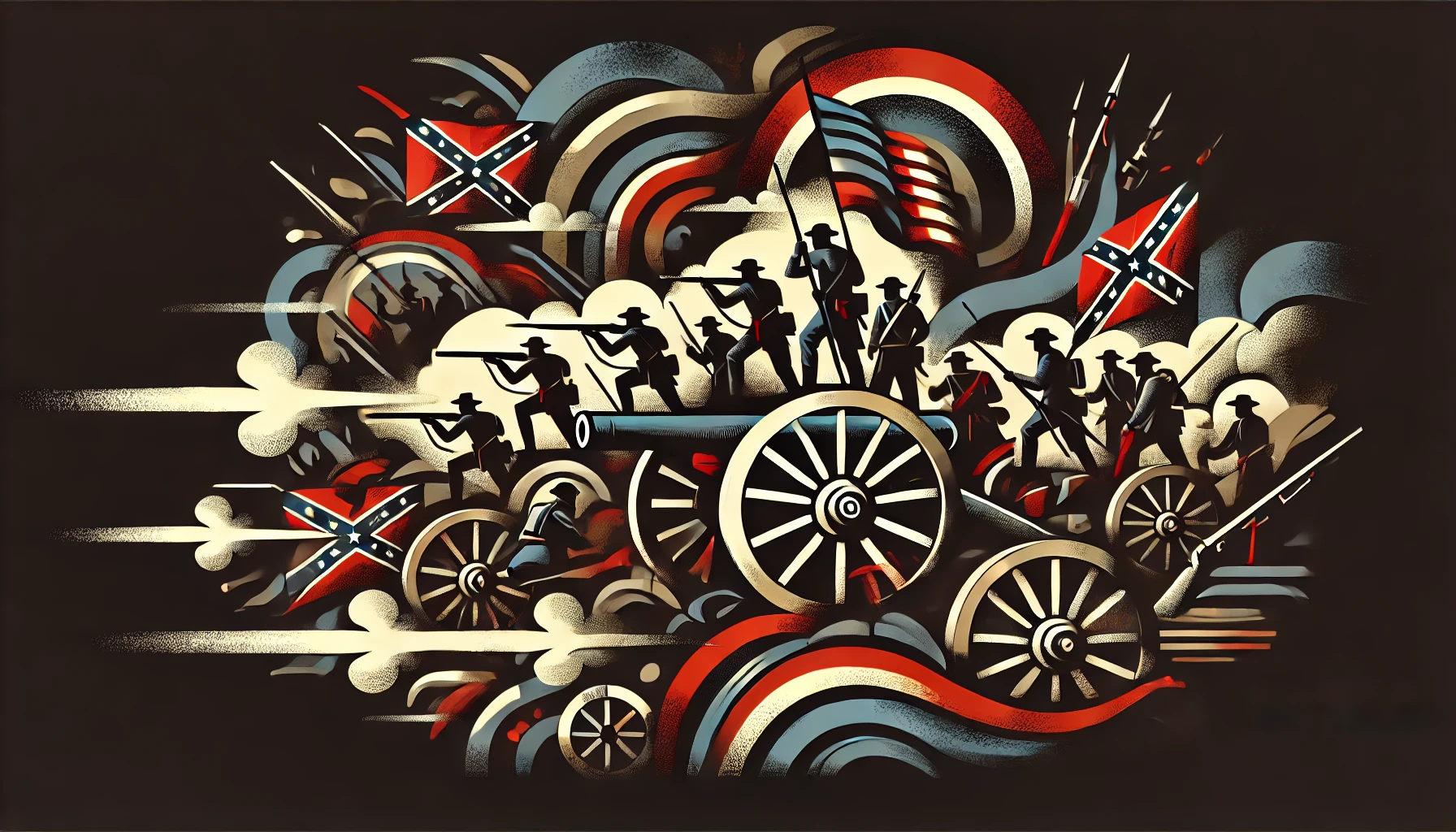
- This event has passed.
Battle of Gettysburg
July 1

The Battle of Gettysburg, fought from July 1 to July 3, 1863, stands as one of the most crucial engagements in American history. This monumental battle not only marked a turning point in the Civil War but also played a significant role in shaping the nation’s future. The sheer scale of the conflict and the strategic decisions made by both the Union and Confederate forces have been subjects of extensive study and reflection. As we commemorate this historic event, we pay tribute to the bravery and sacrifices of those who fought on the hallowed grounds of Gettysburg.
The significance of the Battle of Gettysburg cannot be overstated. It was here that the Union forces, under the command of General George G. Meade, repelled the second and most ambitious invasion of the North by Confederate General Robert E. Lee. The victory at Gettysburg ended Lee’s hopes of securing a decisive victory on Northern soil, which could have potentially led to European recognition of the Confederacy and a negotiated peace. Instead, the Union’s triumph bolstered Northern morale and solidified President Abraham Lincoln’s resolve to continue the fight for reunification and the abolition of slavery.
Commemorating the Battle of Gettysburg has become an integral part of American heritage. Each year, reenactments, educational programs, and memorial services are held to honor the memory of the soldiers who fought and died. These events not only serve as a reminder of the sacrifices made but also as a means to educate future generations about the profound impact of the Civil War on the United States.
Historical Background
The Battle of Gettysburg was the culmination of a series of events that began with General Robert E. Lee’s decision to invade the North in the summer of 1863. Following his victory at the Battle of Chancellorsville in May, Lee sought to capitalize on his momentum by launching an offensive into Pennsylvania. His goal was to relieve pressure on war-torn Virginia, gather supplies from the rich farmlands of the North, and potentially sway public opinion in the Union by demonstrating the Confederacy’s strength.
The Confederate Army, comprising approximately 75,000 soldiers, advanced into Pennsylvania with the hope of drawing Union forces away from the Southern states. In response, the Union Army of the Potomac, numbering around 93,000 men and commanded by General George G. Meade, moved north to confront Lee’s forces. The two armies ultimately clashed near the small town of Gettysburg, Pennsylvania, setting the stage for one of the most intense and consequential battles of the Civil War.
Gettysburg’s strategic importance lay in its network of roads that converged on the town, making it a vital transportation hub. Control of Gettysburg would provide a significant logistical advantage to either side. Moreover, the surrounding terrain, including hills and ridges, offered critical defensive positions that would be fiercely contested over the course of the three-day battle.
The Battle Unfolds
The Battle of Gettysburg began on July 1, 1863, with Confederate forces launching an attack against Union cavalry units stationed west of the town. As reinforcements arrived, the fighting intensified, and by the end of the day, Confederate troops had pushed the Union forces back through Gettysburg to defensive positions on Cemetery Hill and Cemetery Ridge. Despite initial setbacks, the Union soldiers held their ground, setting the stage for a prolonged and bloody conflict.
On July 2, the battle escalated as Lee ordered assaults on both flanks of the Union line. The fighting at locations such as Little Round Top, Devil’s Den, and the Wheatfield became legendary for its ferocity and high casualties. Despite some initial Confederate successes, Union forces managed to hold key positions, thanks in part to the heroic actions of officers like Colonel Joshua Chamberlain and his 20th Maine regiment at Little Round Top.
The climax of the Battle of Gettysburg occurred on July 3, with the infamous Pickett’s Charge. In a bold and desperate maneuver, Lee ordered a massive frontal assault on the center of the Union line at Cemetery Ridge. Approximately 12,500 Confederate soldiers, led by General George Pickett, marched across open fields under heavy artillery and rifle fire. The attack ended in devastating losses for the Confederates, effectively sealing the Union’s victory at Gettysburg.
Aftermath and Impact
The aftermath of the Battle of Gettysburg was both immediate and far-reaching. In the short term, the battle resulted in staggering casualties on both sides, with estimates of around 51,000 soldiers killed, wounded, or missing. The town of Gettysburg itself was left to deal with the gruesome task of caring for the wounded and burying the dead. The scale of the battle and its toll on human life underscored the brutal reality of the Civil War.
Strategically, the Union victory at Gettysburg marked a turning point in the conflict. Lee’s retreat back to Virginia signaled the end of his second invasion of the North and dashed Confederate hopes of achieving a decisive victory on Union soil. The defeat weakened Confederate morale and military capability, while simultaneously bolstering the resolve of the Union forces and their supporters. The momentum gained at Gettysburg paved the way for subsequent Union victories, including General Ulysses S. Grant’s successful campaign to capture Vicksburg.
In the long term, the Battle of Gettysburg had a profound impact on American history. President Abraham Lincoln’s Gettysburg Address, delivered at the dedication of the Soldiers’ National Cemetery in November 1863, eloquently framed the significance of the battle and the broader struggle for national unity and human equality. Lincoln’s words, “that this nation, under God, shall have a new birth of freedom,” have resonated through the ages as a powerful affirmation of the values upon which the United States was founded.
Commemorating the Battle Today
Today, the Battle of Gettysburg is commemorated with reverence and respect. Each year, thousands of visitors from across the nation and around the world come to Gettysburg to pay their respects and learn about this pivotal moment in history. The Gettysburg National Military Park preserves the battlefield and offers a wealth of educational resources, including guided tours, museum exhibits, and reenactments that bring the history of the battle to life.
One of the most notable events in the commemoration of the Battle of Gettysburg is the annual reenactment, which draws history enthusiasts and reenactors who meticulously recreate the battle’s key moments. These reenactments provide a vivid and immersive experience, allowing participants and spectators alike to gain a deeper understanding of the conditions and challenges faced by the soldiers who fought there.
Additionally, the town of Gettysburg hosts various events and activities throughout the year, including lectures, concerts, and memorial services. These events serve not only to honor the memory of those who fought but also to foster a sense of community and historical awareness. By reflecting on the lessons of the past, we can better appreciate the sacrifices made and the enduring legacy of the Battle of Gettysburg.
Author’s Opinion
The Battle of Gettysburg remains a testament to the resilience and determination of the human spirit in the face of adversity. It serves as a poignant reminder of the sacrifices made by countless individuals in the pursuit of freedom and unity. As we commemorate this historic event, we not only honor the memory of those who fought but also reaffirm our commitment to the values that define us as a nation. The lessons learned from Gettysburg continue to inspire and guide us, ensuring that the legacy of this pivotal battle endures for generations to come.
10 Wishes on the Theme of Battle of Gettysburg
- May we always remember the bravery and sacrifice of those who fought at Gettysburg.
- May the lessons of Gettysburg guide us toward unity and peace.
- May the legacy of Gettysburg inspire future generations to honor and preserve our history.
- May the spirit of those who fought at Gettysburg continue to inspire courage and resilience.
- May we strive to uphold the values of freedom and equality for which so many gave their lives.
- May the memory of Gettysburg remind us of the cost of war and the value of peace.
- May the heroes of Gettysburg be forever honored and remembered.
- May the battlefields of Gettysburg serve as a place of reflection and learning.
- May we draw strength from the sacrifices made at Gettysburg in our own struggles for justice.
- May the commemoration of Gettysburg bring us closer to a more united and understanding nation.
10 Unusual Facts on the Topic of Battle of Gettysburg
- The Battle of Gettysburg was fought over shoes. Initially, Confederate troops were in Gettysburg searching for a supply of shoes.
- A single civilian, Ginnie Wade, was killed during the battle while baking bread in her sister’s home.
- The battle produced the largest number of casualties in the entire Civil War, with estimates around 51,000.
- Many soldiers who fought at Gettysburg were buried in shallow graves and later reinterred in the Soldiers’ National Cemetery.
- The Union Army had a slight numerical advantage, with approximately 93,000 soldiers compared to the Confederates’ 75,000.
- General Robert E. Lee’s horse, Traveller, survived the battle and lived until 1871.
- The famous Pickett’s Charge involved a mile-long march across open fields under heavy fire.
- The battle included significant use of artillery, with over 600 cannons fired.
- The battlefield has numerous monuments, with over 1,300 markers and memorials.
- The Gettysburg Cyclorama, a massive panoramic painting of Pickett’s Charge, provides a unique and immersive depiction of the battle.




